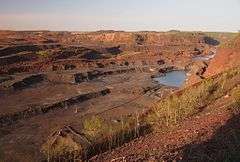Hull–Rust–Mahoning Open Pit Iron Mine
|
Hull-Rust-Mahoning Open Pit Iron Mine | |
|
Hull–Rust–Mahoning Mine from an overlook | |
| Nearest city | Hibbing, Minnesota |
|---|---|
| Coordinates | 47°27′00″N 92°57′00″W / 47.45000°N 92.95000°WCoordinates: 47°27′00″N 92°57′00″W / 47.45000°N 92.95000°W |
| Built | 1893–1894 |
| NRHP Reference # | 66000904[1] |
| Significant dates | |
| Added to NRHP | November 13, 1966[1] |
| Designated NHL | November 13, 1966 |
The Hull-Rust-Mahoning Mine in Hibbing, Minnesota, United States, is one of the largest open pit iron mines in the world, with a 1.5 by 3.5 mile footprint and depths up to 600 feet. The mine, located in the Mesabi Range, supplied as much as one-fourth of all the iron ore mined in the United States during its peak production during World War I and World War II.[2]

This area of the Mesabi Range was explored in 1893–1894, shortly after the Mountain Iron mine was established in 1892. The early development was as an underground mine, but open pit mining soon proved to be a better choice because of the shallow nature of the ore deposits. The many smaller open pit mines developed in the area soon merged into one large mine. The growth of the mine even resulted in the town of Hibbing being relocated to accommodate expansion. The move started in 1919 and took two years to complete at a cost of $16,000,000. 185 houses and 20 businesses were moved, and some of the larger buildings had to be cut in half for the move. Only a few uninhabited remnants of the original townsite are left near an observational lookout at the edge of the mine.
Over 519 million tons of waste material and 690 million tons of iron ore have been removed from the mine area since ore shipments began in 1895. The mine was listed as a National Historic Landmark, and added to the National Register of Historic Places on November 13, 1966. The mine is still operated today by the Hibbing Taconite Company, and iron ore "taconite" pellets are produced at the rate of 8.2 million tons annually (not counting tailings, waste rock, or overburden).
See also
- List of National Historic Landmarks in Minnesota
- National Register of Historic Places listings in St. Louis County, Minnesota
References
- 1 2 National Park Service (2010-07-09). "National Register Information System". National Register of Historic Places. National Park Service.
- ↑ Charles Snell (June 1, 1966). "National Register of Historic Places Inventory-Nomination: Hull-Rust-Mahoning Open Pit Iron Mine" (pdf). National Park Service. and Accompanying 6 images (694 KB)
- "National Register of Historic Places — Hull-Rust-Mahoning Mine". Minnesota Historical Society. 2001. Retrieved 2006-11-10.
- "City of Hibbing — North Hibbing — Hull Rust Mahoning Mine Walking Tour". City of Hibbing. Retrieved 2006-11-10.
- "Cleveland-Cliffs Inc: Mining Operations and Technology". 2006. Archived from the original on 2006-10-17. Retrieved 2006-11-10.
External links
| Wikimedia Commons has media related to Hull-Rust-Mahoning Open Pit Iron Mine. |
